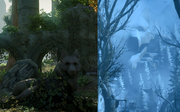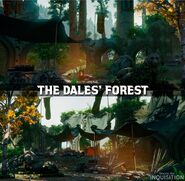(remove trivia w/dead link) Tag: sourceedit |
Tag: sourceedit |
||
| Line 48: | Line 48: | ||
{{SpoilerDAI| |
{{SpoilerDAI| |
||
| − | {{CodexConditionalParagraph|If Briala |
+ | {{CodexConditionalParagraph|If Briala rules alongside Gaspard or reconciled with Celene|}} |
[[Briala]] was named Marquise of the Dales by the Orlesian Monarch, in recognition of her 'service' to Orlais. The Dales are once again ruled by an elf for the first time since the Glory Age. |
[[Briala]] was named Marquise of the Dales by the Orlesian Monarch, in recognition of her 'service' to Orlais. The Dales are once again ruled by an elf for the first time since the Glory Age. |
||
}} |
}} |
||
Revision as of 09:13, 22 September 2016
The Dales are the area of southeastern Orlais to the west of Ferelden. From -165 Ancient[1] to 2:20 Glory—a period of nearly three centuries—they were the homeland of the elves of Thedas.
History
The Dales still bear the scars of the Exalted March: a time long ago when the might of the Orlesian Empire crushed elven forces and drove them from their own land.
Although the nation of Orlais now lays claim to the Dales, every branch, stream, and stone preserve the memories of elven history.
From the lush forests of the Emerald Graves to the icy highlands of Emprise du Lion, fractured remnants of the ancient elves live on.
—: Exploring The Dales
The Founding of the Dales
During the centuries of slavery, after their ancient civilization of Elvhenan fell to the Tevinter Imperium, the elves lost most of their language, history and lore. However, when Andraste and her husband Maferath led their Alamarri army against Tevinter in 1020 TE,[2] the elven slaves led by Shartan rose up and helped fight against their masters.
Shartan was killed when Andraste was betrayed to the Tevinters, but in 1025 TE, Maferath and Andraste's sons gave the elves the Dales as a reward for their part in the war. At that time, the Dales were on the fringe of Tevinter territory and were barely populated, with only the scattered Ciriane people to the west, and the barbarians of Fereldan Valley on the other side of the Frostback Mountains. The freed elves set off for their new home from Tevinter on foot in what would come to be called "The Long Walk". Many perished along the way, but those who survived founded the city of Halamshiral – meaning "the end of the journey" in Elvish. They were joined by elves from across Thedas and began the task of restoring their lost language, religion and lore.

Carvings of the "Knights's Guardians" of the Emerald Knights
The Dales were patrolled by a border guard known as the Emerald Knights. These elven warriors protected the boundaries of the realm, riding halla mounts[3] and accompanied by their steadfast wolf companions known as "Knight's Guardians." These loyal wolves fought and lived with the Emerald Knights and guarded them as they slept.[4]
The Fall of the Dales
“Andraste's path was difficult, as was ours. But we did not falter, as she did not. And we will be rewarded, just as she was. Elves were guilty of the greatest sin, of turning from the Maker. But we will show them mercy, for that is what Andraste teaches...when her chant is spoken from all countries of the world, the Maker will return. We are one day closer to his coming. Even Maferath the Betrayer had a part to play. Who are we to say elves do not?” ―From a sermon given by Sister Amity, at the conclusion of the Exalted March of the Dales
In their attempt to maintain their independence and regain the lost glory of Elvhenan, the elves cut themselves off from their human neighbors in Orlais, a nation forged through Drakon's Exalted Marches against his neighbors. Throughout the Second Blight, which lasted for most of the Divine Age, the elves of the Dales remained neutral and unhelpful. When the city of Montsimmard was nearly destroyed by darkspawn in 1:25 Divine, it is alleged that an elven army watched from a nearby hilltop and did nothing. Their apparent indifference and non-Andrastian religious views fueled increasing hostility between the Dales and Orlais after the Blight. For example, rumors spread among the Orlesian people that the heathen elves practiced human sacrifice. According to human accounts, border skirmishes escalated into full-scale war after elven forces attacked the Orlesian town of Red Crossing in 2:9 Glory. The Dalish claim the war started after the Chantry sent templars into their territory after the elves forcibly removed Andrastian missionaries from the Dales.[5]
By 2:10 Glory, elven forces had captured Montsimmard and advanced to the doorstep of Val Royeaux. Elven occupation didn't last long however, and in Orlais' resurgence the chevalier Ser Yves de Chevac struck down the elven forces' commander with a shot to the throat at two hundred feet.[7]
At this point, the Chantry called for a holy war against the elves that became known as the Exalted March of the Dales. Orlais was the only nation to provide troops. The elves were pushed back to the border by Orlesian forces. Halamshiral was conquered and the elves were completely crushed by 2:20 Glory. The Dales were claimed by the Orlesians, who uprooted elven settlements and forbade worship of the elven gods.[2] Elves who accepted the Chantry's offered truce were required to accept the Maker and live in slums, known as alienages, within human settlements, becoming the city elves. Some elves, however, refused to give up their worship or their dream of a homeland. These became the nomadic Dalish, retaining the name of their second lost homeland and vowing to keep the elven language, history and religion alive.
After the Fall
Ville Montevelan in the Exalted Plains was the first settlement humans established in the Dales following their victory of the Exalted March. Soldiers were the earliest residents of the village. In 2:21 Glory, Sister Amity, champion of the Exalted March, laid the foundation stones of the village chantry in a symbolic gesture; the construction was completed in 2:22. Amity lay aside her sword and bow to become Revered Mother Amity; she served in Ville Montevelan until she died peacefully in her sleep in 2:64. Her ashes are interred in the chantry's vault, where dozens of pilgrims still come each year to pay their respects.[8]
Elven ruins still litter the Dales. Some, like Citadelle du Corbeau, have been reclaimed and repurposed by humans.
War of the Lions
Notable areas
- Emerald Graves: home to an elven burial site where a tree was planted for each soldier killed in the Exalted Marches.
- Exalted Plains: where the elves of old made their last stand before they were defeated.
- Halamshiral: capital city during the time when the Dales were home to the elven nation. Home to the Winter Palace, which has since become an estate in the possession of Empress Celene.
- Emprise du Lion
Gallery
References
- ↑
 Dragon Age: The World of Thedas, vol. 1, p. 46
Dragon Age: The World of Thedas, vol. 1, p. 46
- ↑ 2.0 2.1 Dragon Age: Origins: Prima Official Game Guide, Collector's Edition, p. 342
- ↑
 Dragon Age: The World of Thedas, vol. 1, p. 32
Dragon Age: The World of Thedas, vol. 1, p. 32
- ↑ Codex entry: Knight's Guardian
- ↑ Codex entry: The Dales
- ↑ Codex entry: The Death of Elandrin
- ↑ Bane of Red Crossing
- ↑ Codex entry: Ville Montevelan
| ||||||||||||||||||
| -7601 Ancient -6405 TE 0 FA |
Arlathan (0 FA–6625 FA) · Orseck Garal (~6350 FA) · Darinius (†15 TE) · Endrin Stonehammer (†64 TE) · First Blight (800–992 TE) · Aeducan (~815 TE) · Caridin (†947 TE) · Andraste (992–1025 TE) · Dales (1030–1314 TE) · Inquisition (1095–1214 TE) · Emperor Kordillus Drakon I (1159–1239 TE) | -2 Ancient 1194 TE 7599 FA |
| Timeline · Calendar | ||
| Ancient Age · Divine Age · Glory Age · Towers Age · Black Age · Exalted Age · Steel Age · Storm Age · Blessed Age · Dragon Age | ||





